Neurotrophic Properties of C-Terminal Domain of the Heavy Chain of Tetanus Toxin on Motor Neuron Disease
- PMID: 33096857
- PMCID: PMC7589688
- DOI: 10.3390/toxins12100666
Neurotrophic Properties of C-Terminal Domain of the Heavy Chain of Tetanus Toxin on Motor Neuron Disease
Abstract
The carboxyl-terminal domain of the heavy chain of tetanus toxin (Hc-TeTx) exerts a neuroprotective effect in neurodegenerative diseases via the activation of signaling pathways related to neurotrophins, and also through inhibiting apoptotic cell death. Here, we demonstrate that Hc-TeTx preserves motoneurons from chronic excitotoxicity in an in vitro model of amyotrophic lateral sclerosis. Furthermore, we found that PI3-K/Akt pathway, but not p21ras/MAPK pathway, is involved in their beneficial effects under chronic excitotoxicity. Moreover, we corroborate the capacity of the Hc-TeTx to be transported retrogradely into the spinal motor neurons and also its capacity to bind to the motoneuron-like cell line NSC-34. These findings suggest a possible therapeutic tool to improve motoneuron preservation in neurodegenerative diseases such as amyotrophic lateral sclerosis.
Keywords: amyotrophic lateral sclerosis; carboxyl-terminal domain of the heavy chain of tetanus toxin; excitotoxicity; neuroprotection; spinal muscular atrophy.
Conflict of interest statement
The authors declare no conflict of interest.
Figures




Similar articles
-
A glial cell line-derived neurotrophic factor (GDNF):tetanus toxin fragment C protein conjugate improves delivery of GDNF to spinal cord motor neurons in mice.Brain Res. 2006 Nov 20;1120(1):1-12. doi: 10.1016/j.brainres.2006.08.079. Epub 2006 Oct 3. Brain Res. 2006. PMID: 17020749
-
The C-terminal domain of tetanus toxin protects motoneurons against acute excitotoxic damage on spinal cord organotypic cultures.J Neurochem. 2013 Jan;124(1):36-44. doi: 10.1111/jnc.12062. Epub 2012 Nov 15. J Neurochem. 2013. PMID: 23106494
-
Neuroprotective Effects of C-terminal Domain of Tetanus Toxin on Rat Brain Against Motorneuron Damages After Experimental Spinal Cord Injury.Spine (Phila Pa 1976). 2018 Mar 15;43(6):E327-E333. doi: 10.1097/BRS.0000000000002357. Spine (Phila Pa 1976). 2018. PMID: 28767631
-
Riluzole: what it does to spinal and brainstem neurons and how it does it.Neuroscientist. 2013 Apr;19(2):137-44. doi: 10.1177/1073858412444932. Epub 2012 May 16. Neuroscientist. 2013. PMID: 22596264 Review.
-
Calcium dysregulation in amyotrophic lateral sclerosis.Cell Calcium. 2010 Feb;47(2):165-74. doi: 10.1016/j.ceca.2009.12.002. Epub 2010 Jan 29. Cell Calcium. 2010. PMID: 20116097 Review.
Cited by
-
Neurotrophic fragments as therapeutic alternatives to ameliorate brain aging.Neural Regen Res. 2023 Jan;18(1):51-56. doi: 10.4103/1673-5374.331867. Neural Regen Res. 2023. PMID: 35799508 Free PMC article. Review.
-
ICA-27243 improves neuromuscular function and preserves motoneurons in the transgenic SOD1G93A mice.Neurotherapeutics. 2024 Mar;21(2):e00319. doi: 10.1016/j.neurot.2024.e00319. Epub 2024 Jan 22. Neurotherapeutics. 2024. PMID: 38262101 Free PMC article.
References
-
- Abe K., Aoki M., Tsuji S., Itoyama Y., Sobue G., Togo M., Hamada C., Tanaka M., Akimoto M., Nakamura K., et al. Safety and efficacy of edaravone in well defined patients with amyotrophic lateral sclerosis: A randomised, double-blind, placebo-controlled trial. Lancet Neurol. 2017;16:505–512. doi: 10.1016/S1474-4422(17)30115-1. - DOI - PubMed
Publication types
MeSH terms
Substances
Grants and funding
LinkOut - more resources
Full Text Sources
Medical
Research Materials

